-
|
| MARINE
LIFE NEWS
Reports
of marine wildlife from all around the British Isles, with pollution incidents
and conservation initiatives as they affect the flora and fauna of the
NE Atlantic Ocean
August
2016
A
huge 7.65 kg (17 lb) European
Lobster,
Homarus gammarus (= H. vulgaris),
was captured by free diver Joe Pike
off Lannacombe
Beach, south Devon. It was captured and taken to the National
Aquarium at Plymouth for further captive
study. It is the second largest European
Lobster on record as a confirmed weight although
from the size and weights of remains, even larger Lobsters
could be extant.
|
|
.jpg) |
19
August 2016
The
asymmetric coloration of the baleen plates confirm that the baleen whale
which stranded at Shankill
in County Dublin, Ireland,
was a juvenile female Fin Whale, Balaenoptera
physalus.
|
11
August 2016
Two
divers at the Zeeland
Bridge discovered a Sponge Crab,
Dromia
personata, for the very first time
in murky seas off the Netherlands. The Wolkrab
(Dutch name) takes its name from a brown-red, velvety hair. With its wide
and high rising carapace and with powerful claws, it makes a strong impression.
The bare ends of the claws (chelae)
are sometimes coloured like pink nail polish and contrast sharply with
the rest of the body. It is a southern species with its northerly point
of distribution previously in the seas off Belgium and the Thames estuary
where it is uncommon. It rear legs can hold a sponge
in place for camouflage.
|
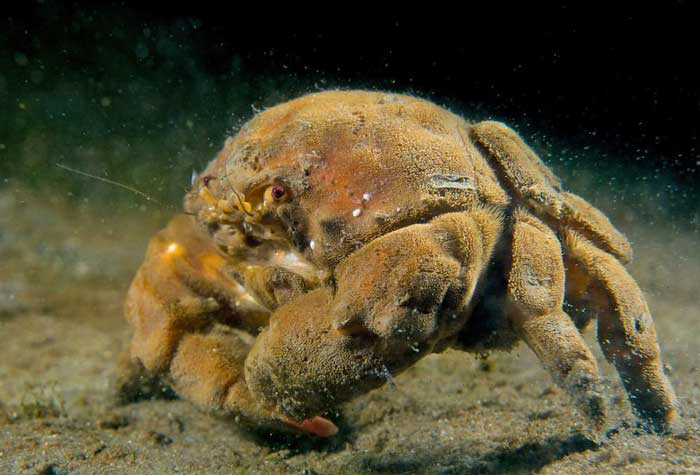 |
5
August 2016
.jpg)
"John Coe" Killer Whale
off the Hebrides
Photograph
by Basking
Shark Scotland
facebook
The
famous Killer Whale, Orcinus orca,
named 'John Coe"
was spotted off the Hebrides. It is the largest bull
Orca
in the few remaining members of the 'Hebridean
Community' of Killer Whales (or Western
Community): a
community living of the western seas of Ireland and Scotland.
It is rarely seen but was spotted off Ireland on 27
June 2016.
John
Coe (Irish Sightings Map)
1
August 2016
A
Humpback Whale, Megaptera
novaengliae, was spotted by Lee
Watson, (a volunteer with British
Divers Marine Life Rescue, BDMLR), "lunge
feeding" (swimming through a shoal of small fish with its huge mouth
wide open), bursting through the surface of the water off Newburgh,
Aberdeenshire,
east coast of Scotland. .
BMLSS
Cetacea
31
July 2016
Anglers
caught a huge Thresher
Shark, Alopias vulpinus,
estimated from measurements to weigh 167 kg (368 lb), from a boat
off the coast of Cornwall.
BMLSS
Thresher Sharks
July
2016
For
a majestic month the residents of the Shetland
Isles enjoyed views of several (maybe four) pods of the Northern
Isles Community of Killer Whales, Orcinus
orca, roaming up and down the rocky
coasts of the archipelago, mainly seen from the east shores of Mainland,
but nowhere were they predictable, seen coming close inshore under the
cliffs and seen feeding on shoals of fish,
ducks,
seals
and a Porpoise.
Shetland
Wildlife Orca Gallery
FORUM
NEWS
Marine Wildlife
of the North-east Atlantic Ocean Mailing Groups
.jpg)
Marine
Wildlife of the North-east Atlantic Ocean
Yahoo
Group
New
Group:
http://uk.groups.yahoo.com/group/Glaucus

British
Marine Life Study Society
facebook
Page:
https://www.facebook.com/groups/glaucus/
This
is designed for quick less important chatty news items. Photographs can
be uploaded quickly which is only possible on the Yahoo Group by going
to the web page.

Images can be
uploaded to flickr.
http://www.flickr.com/groups/glaucus/
Wet
Thumb (Marine Aquariology) Forum Link


|
Lots
of marine wildlife reports from Shetland on facebook
Photographs
include undersea, sea mammals and birds.
Click
on the image to connect |

All
reports by Andy Horton unless the credits are given
to
other observers or reporters.
Cornish
Marine Wildlife (Ray Dennis Records) 2009
|
|
PICTURE
GALLERY
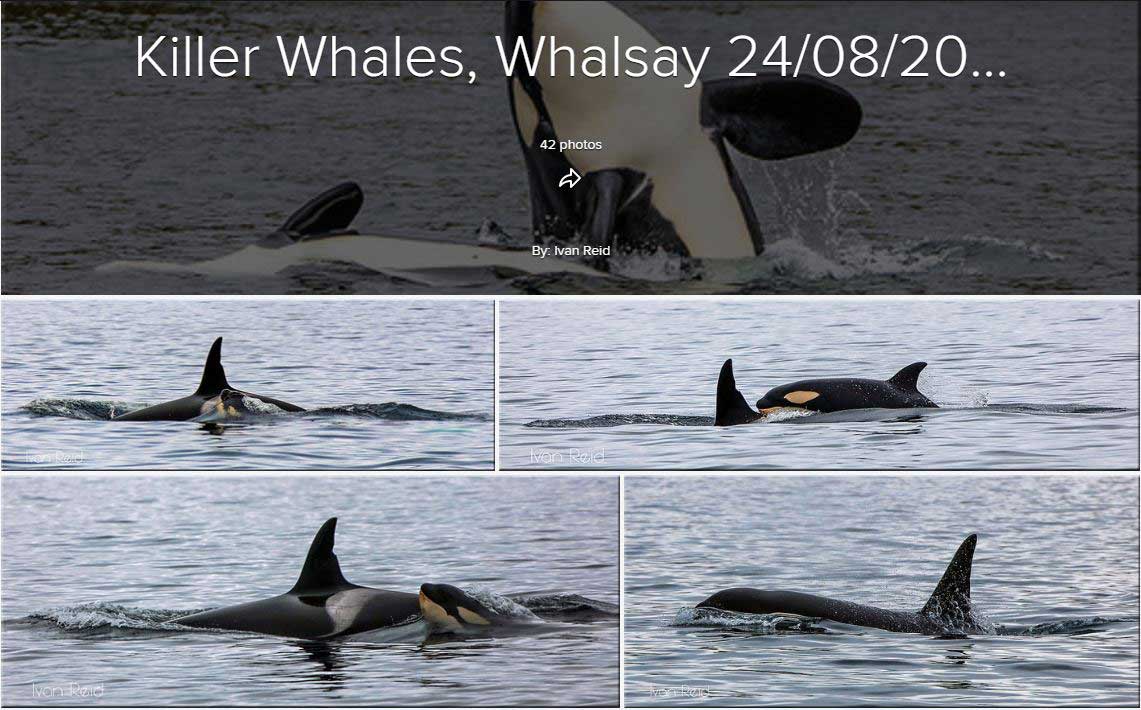
Killer
Whales, Shetland Isles
Photographs
by Ivan Reid
This
pod of Killer Whales were seen off the west coast of Whalsay,
under a low cloud and mostly calm dry conditions. The Killer Whales, Orcinus
orca, were first spotted on the east side of the Calf
of Linga an island which is situated off Symbister
Harbour. The whales then proceeded into the north west travelling between
islands Bruceholm and Hunderholm headed to a bight
which lays off mainland Shetland called Bunnydale, here the whales frolicked
around breaching and playing swimming upside down etc. They then left this
location and headed south again around the island of Hunderholm and carried
on proceeding south towards Nesting
and Lerwick area. In
the pod there were two large Killer Whales and three smaller cubs. The
whales travelled at a speed around 6-7 knots into the south.
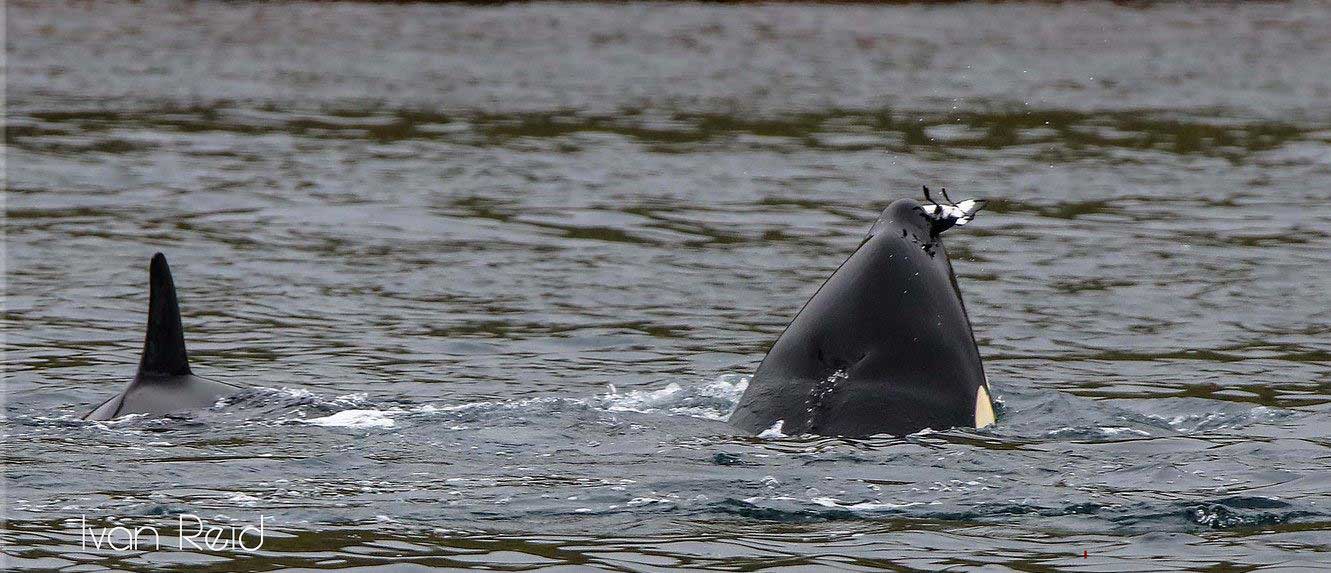
Killer
Whale snacking on a Tystie
Photograph
by Ivan Reid
"At
one stage I lost sight of the Orcas and thought they had gone, only
to see two of the bigger whales under the water: It seemed as if they were
coming for the boat at pace, but they veered off and went under out of
sight just feet from the boat side.”
Commentary
by Ivan Reid
Shetland
News Report

Shetland
Orca Sightings facebook
Each
month, at least one special marine image will be published from images
sent to the BMLSS. This
can be of the seashore, undersea world or any
aspect of the marine natural world, especially the underwater life, but
not restricted to life beneath the waves. Topical inclusions may be included
instead of the most meritorious, and images will be limited to the NE Atlantic
Ocean and adjoining seas, marine and seashore species and land and seascapes.
Click
on the images for the original photographs or links to more images
flickr
MARINE
LIFE of the NE Atlantic GALLERY
Shorewatch
Biological Recording
Gallery
---------------------------------------------------------------------------------------------------------------------------------------------------------------
Shore
Topography Series
The
name of the particular coast should be included and any other interesting
information including the grid reference, if known. Print photographs can
be included in Exhibitions and on the BMLSS Web
Sites and electronic publications.
Electronic
images in *.jpg
format can also be considered for the web site. They should not exceed
1 Mb in size.
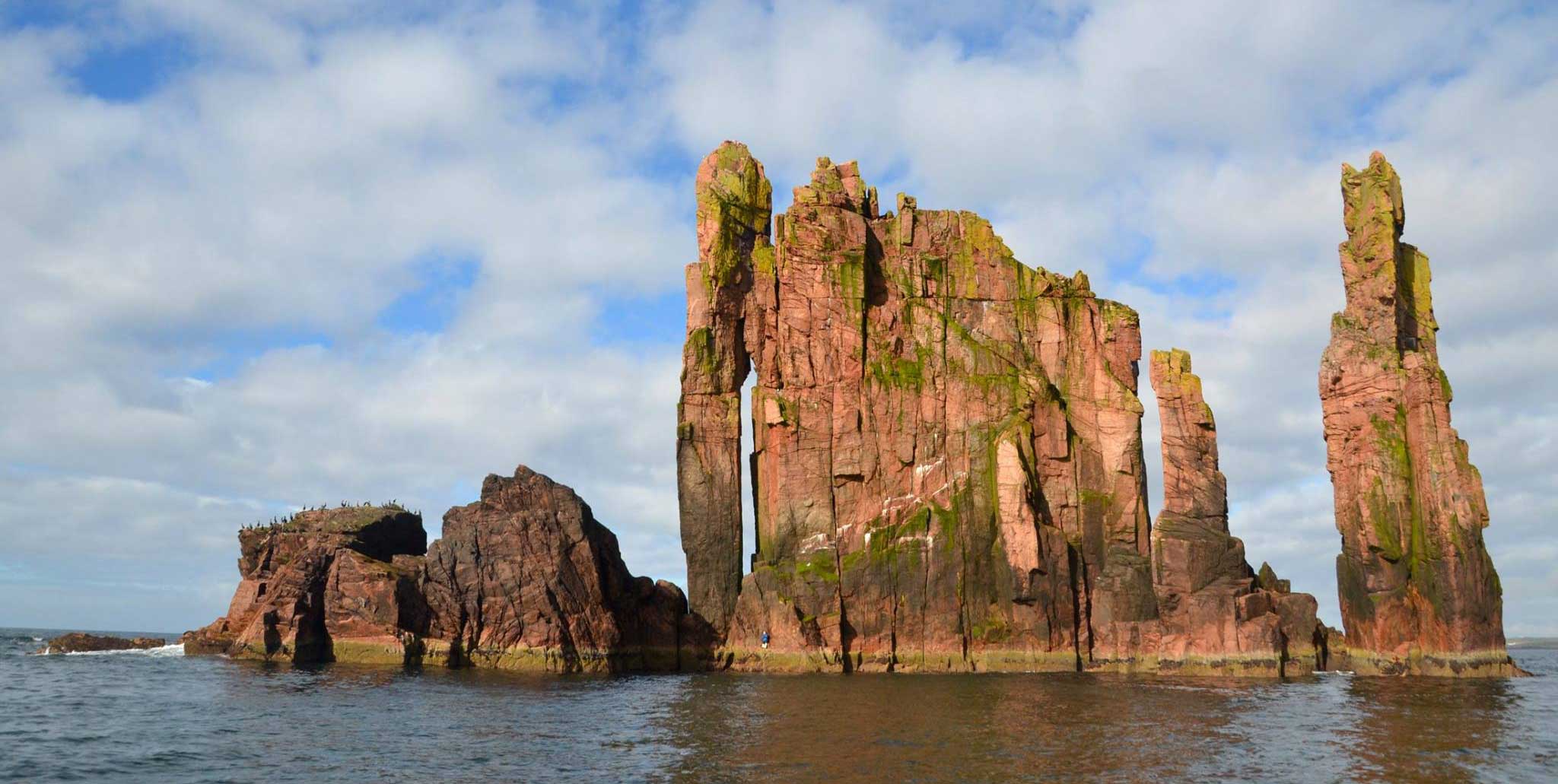
The
Drongs, nr Eshaness, north St.
Magnus Bay
Shetland
Isles
Photographs
by Ryan Leith
The Drongs
are a spectacular series of granitesea
stacks off the Ness
of Hillswick. They are visible from the road between Hillswick
and Eshaness, north-west
Mainland, Shetland. These stacks are 1 km offshore and in water depths
of over 70 metres just 100 metres away. They get a severe wave battering
in their exposed location. Spot the person (Maurice
Henderson) for the scale.
Shetland
Sea Stacks
Click
on the images for the original photographs or links to more images

flickr
British
Coastal Topography
.jpg)
facebook
British
Coastal Topography
----------------------------------------------------------------------------
First
enquiry by EMail
to Glaucus@hotmail.com

-----------------------------------------------------------------------
Photographers
submitting pictures should indicate if they wish them to be considered
for inclusion as confirming permission takes work and time and can delay
publication of the news bulletins.

Click
on the album for more links (On-line link)
|
|
EVENTS
& DIARY
In
chronological order, the most recent events are at the top of the page.
Events open to the public, free or for a nominal charge only are included.
Most Seminars need to be booked in advance.
 |
For
details of the Porcupine Marine Nature History Society meetings click on
the link on the left
|
|
| PUBLIC
AQUARIA NEWS |
| Public
Aquaria List |
| CETACEAN
NEWS |
|
? What
to do if you find a stranded whale or dolphin ?

|
If
you find a LIVE stranded or injured whale or dolphin on the beach you must
send for help QUICKLY. A whale or dolphin stranding is an emergency and
the speed of response by a professional rescue team is perhaps the most
crucial factor in determining whether or not an animal can be returned
to the sea alive.
|
ENGLAND
|
WALES
|
SCOTLAND
|
|
0300 1234
999
|
0300 1234
999
|
0131 339
0111
|
|
CORNWALL
|
JERSEY
|
GUERNSEY
|
|
0845 201
2626
|
01534 724331
|
00 44 1481
257261
|
Would you know what to
do if you found a whale stranded on a beach?
Each year anywhere between
five and 50 whales, dolphins and porpoises are washed up on Britain's beaches.
British
Divers Marine Life Rescue, a volunteer charity, was set up in 1998
to rescue them.
BBC
News Report
LINK
TO THE STRANDINGS PAGE
|
|
PUBLICATIONS
&
WEB PAGES
BOOKS
PUBLICATIONS
NEW
BOOKS

Shallow Seas (Collins
New Naturalist Library)
by
Peter Hayward (Author)
The
Marine World: A Natural History of Ocean Life

The Marine World
Includes
sections on all but the most obscure marine groups, covering invertebrate
phyla from sponges to sea squirts, as well as plants, fungi, bacteria,
fish, reptiles, mammals and birds
Incorporates
information on identification, distribution, structure, biology, ecology,
classification and conservation of each group
by:
Frances Dipper (Author), Marc Dando (Illustrator), Mark Carwardine (foreword)
544
pages, 1500+ colour photos, colour & b/w illustrations, colour tables
Wild
Nature Press
Click
on the book pictures for more information
The
Essential Guide to Beachcombing and the Strandline
This
richly
illustrated guide will become a steadfast companion for beach visitors
wishing to identify what the sea washes up
By:
Steve Trewhella (Author), Julie Hatcher (Author)
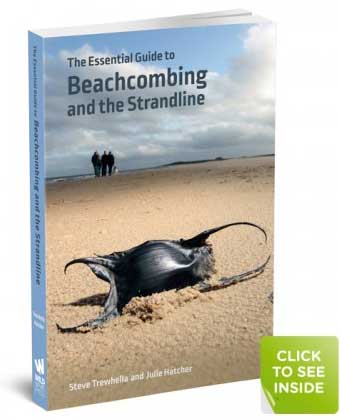
304
pages, colour photos, b/w illustrations
Wild
Nature Press

Fish Atlas of
the Celtic Sea, North Sea, and Baltic Sea
Based
on international research vessel data
Author:
edited by Henk J.L. Heessen, Niels Daan, Jim R. EllisPrice: € 79,50
An
in-depth reference work on marine fish, this is the first complete overview
of all marine fish species found in the North Sea, Baltic Sea, and Celtic
Sea. Whereas European research mainly focuses on species of commercial
interest, this atlas documents current data of all Western European fish
species caught in the period 1977 to 2013.

ESSENTIAL PURCHASE
*****
----------------------------------------------------------------------------------------------------------------------------------

Encyclopaedia
of Marine Life of Britain and Ireland
http://www.habitas.org.uk/marinelife/index.html?item=about
Marine
Fauna of Norway
http://www.seawater.no/fauna/e_index.htm

WET
THUMB (Marine Aquariology)
EFORUM
PAGE
BMLSS:
Marine Life Articles in Publications (Link)
|
SOCIETY
INFORMATION
The
British Marine Life Study Society are responsible for producing the journal
GLAUCUS,
which is the first publication exploring the marine life of the seas surrounding
the British Isles available to the general public. In
future, I expect the publication to be in an electronic format.
-------------------------------------------------------------------------------------------------------------------------
EMail Address
 EMail
address for messages to the British Marine Life Study Society EMail
address for messages to the British Marine Life Study Society
----------------------------------------------------------------------------------------------
Membership 2016
Please
join the facebook
group for free. Formal membership of the Society has ceased. Back
copies of previous issues are still available.
|
|
Bulletin
Details
For
technical reasons, TORPEDO is no longer being sent out by EMail. It is
simply easier to view the bulletins on the web pages.
Subscribe/Unsubcribe
http://groups.yahoo.com/group/BMLSS-Torpedo
The
Bulletin is designed to be viewed on Internet Explorer using medium fonts
at a resolution of 1024 x 768.
Viewing
should be possible on Mozilla and other browsers. |
31 August 2016
|
Copyright
2016 ©
British Marine Life Study Society
---------------------------------------------------------------------------------------------------------------------------------
Compiled
on Netscape Composer 4.6 and other programs
|

